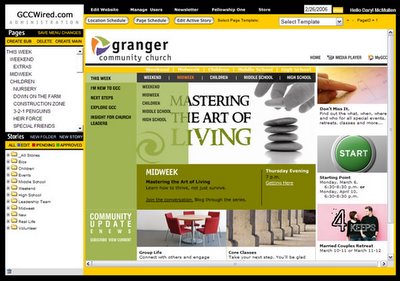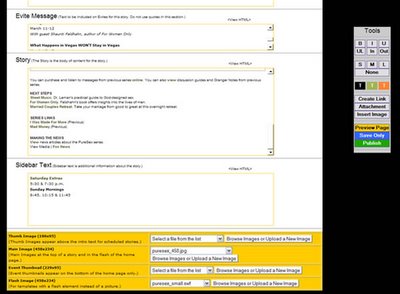22 December 2006
The Pre-Christmas Push
 As Christmas approaches, you can't help but feel the pressure. Yes there are the gifts to buy, the presents to wrap and the cookies to make. But don't forget the completion of web projects, data transfer and product uploads!
As Christmas approaches, you can't help but feel the pressure. Yes there are the gifts to buy, the presents to wrap and the cookies to make. But don't forget the completion of web projects, data transfer and product uploads!
Yes, there is a lot going on in the Communications Department. Here are a few of the big things we've rolled out in the past month:
- New and improved Leadership Page
- Real People Page
- Lots of cool U2 Christmas adds to the Media Player
Here are some of the big projects we're just finishing or still working on:
- New store! WiredChurches.com "2.0" is almost ready to make it's appearance.
- Can't talk about this one...
- Better GCCwired.com user experience when using the Web Link functionality for online transactions like registering for events and giving online.
- Can't really talk about this one either...
- Upgrading hardware, software and systems to support an improved media presentation on the web (from media player to on-demand version of last weeks service). Transitioning from standard video presentation to streaming video for all clips (even the short ones).
- Along with a myriad of small adjustments to our current pages.
Just so you don't think we sit around and blog all day!
30 November 2006
Are You Organized?
 Organization has always been one of my strengths (even though my mother and my wife probably have examples of the exact opposite...). I'm not sure where it came from - but I've been told that it could be related to being a first born with a concrete-sequential personality and a healthy dose of perfectionism thrown in. And while being a perfectionist often leads to neurotic behavior, it can also be used in moderation to stay organized and manage your workload well.
Organization has always been one of my strengths (even though my mother and my wife probably have examples of the exact opposite...). I'm not sure where it came from - but I've been told that it could be related to being a first born with a concrete-sequential personality and a healthy dose of perfectionism thrown in. And while being a perfectionist often leads to neurotic behavior, it can also be used in moderation to stay organized and manage your workload well.
In my previous life (a few months ago) I managed an acute unit in a psychiatric hospital and organization was mandatory. I supervised three clinicians providing services to over forty patients in crisis along with managing statistical analysis of a myriad of variables to keep the administration happy.
When I left the mental health field to become the web director at granger things calmed down for about ten minutes. Fifteen minutes into my new position I was thinking about ways to stay organized in this new environment.
One thing I quickly realized the following:
In order to stay organized in any environment you first need to find out what needs organized. -daryl mcmullen 2006 (like that matters...)This may sound elemental but think about it - all organization is not the same. My organizational strategy and the tools I used at the hospital did not completely transfer to the church environment. The mindset transferred, but many of the strategies and tools did not. Here is a list of the most common things I must keep organized (ranging from macro to micro level tasks in no particular order):
- Relationships: I manage relationships with co-workers, volunteers, other departments, our Senior Management Team (SMT), our web developers, current and potential vendors along with people inquiring about our website, etc.
- Data (files/folders/pictures/video/etc.): Over time "stuff" builds up and can become very disorganized. I am directly involved with web files, image/graphics files, video clips, documents converted to PDF, etc.
- Data (statistics): We are developing strategies to manage the statistics we have access to when it comes to our CMS, our website(s), our eCommerce solution, our enewsletter and our online streaming video usage.
- Information: In every field there is basic/foundational information (capable of being learned in school or from a textbook) and there is progressive/cutting edge information that's so new it must be managed differently. This is where online content, blogs, tutorials, recently published books, periodicals and the like become very helpful.
- Web Development: Managing current projects and identifying the next phase of web development.
- Budget: Managing the cost of our current projects, and leveraging funds for future development.
- Wish List: Developing "cool" new ideas that may or may not become part of future web development projects.
- Web Maintenance: Managing the day to day maintenance of the website(s).
- Doing/Designing: Actual hands on work in terms of maintenance or design work. I spend time in our admin panel adding/scheduling/maintaining content and do a small part of the graphics and flash work on the site.
- Quality Control: A constant focus in terms of site consistency, functionality and integrity.
In order to stay organized in the above areas - here are some organizational strategies and tools you can use. Some work for me and some don't. Likewise, some may work for you and some may not:
- Your brain: Keep track of everything in you brain. Doesn't work for me - more power to you if this works in your world!
- The "2Do List:" The most basic organizational strategy to keep track of stuff and get thing done. Of course this takes place in a myriad of ways. Electronics: desktop, PDA, notebook or even the handy dandy smart phone. Paper: keeping lists on paper is very traditional - but rarely fails you. Whiteboards: awesome way to keep your 2Do list in front of your face all day - but it's not very easy to take with you. Sticky Notes: some people swear by the sticky notes and unless things are written on one of the little yellow squares it won't get finished.
- Email clients: Another organizational tool is your email client. Microsoft Outlook (for example) powerfully integrates your communication (email) with your 2Do list, your contact list, your working documents, etc. If you can wrap your brain around this sort of integration it can take you to amazing places.
- One Note: I do not use One Note (a Microsoft product) but I work with people that swear by it. This application takes your electronic organization to new levels by allowing note taking and document creation as it integrates other Microsoft products like Outlook and Word.
Of course the list could go on and on, but I'll stop for now. The key is not to do what everyone else is doing - the key is to find what works for you and do that.
Good luck!
28 November 2006
Do You Zune?

Not on November 14, 2006 (the launch date). I actually waited until November 15, 2006 just to make sure I wasn't jumping the gun...
My simple review: There are bugs - but I'm glad I bought it.
I must say there are some pretty harsh reviews out there - everything from "trash" to "waste of time and money." And while some seem to have valid arguments, it often ends up being a hard core iPod user or someone with all-or-nothing syndrome (the idea that if there is one single problem you MUST throw the entire thing down the drain).
Now for a slightly more detailed review:
Hardware
The device itself is awesome. I love the size, weight, color, texture, buttons and especially the size of the screen (320x240) which shows your standard 4:3 video crisp and clear. The case itself is strong, solid and the buttons easy to press without being easily bumped. You have the essentials and nothing more to clutter up the device.
Software
I wasn't all that concerned about the software on the device or the software used to download media (Zune Marketplace) probably because I expect bugs at the beginning. And because software is easy to upgrade. Each time you attach the device it downloads necessary updates. And the Marketplace can only get better since it's a web-based ap that receives upgrades in real time.
Now don't get me wrong, bugs do exist:
- I can connect to the Marketplace on my desktop but not on my laptop.
- The Marketplace has no podcast function which means every podcast you have is treated like a song.
- The Marketplace is a bit unstable - having to be shut down every now and then to catch its breath.
User Interface
Love it. Love it. Love it. Of course I am not an iPod user so I have no point of reference. But the navigation is easy and concise. Titles, descriptions, images and the like are all laid out well. The volume indicator is cool as is the flyout menus for images. Throw in an FM radio, the wireless functionality and I'd say you're miles ahead of the game.
Accessories
I purchased the Home A/V Pack which comes with power cord, dock, A/V cable to hook up to your receiver and small remote that looks just like the black Zune. Works well and looks cool too.
I'd recommend: More professional earphones. The ear buds that the Zune comes with are supposed to be cool (magnetic to keep them together during storage) but they aren't cool enough to be my default set...
:)
17 November 2006
Content Management Systems (CMS)
During the Communications Workshop (hosted by WiredChurches.com) someone asked a question about content management solutions that could be leveraged to ease web maintenance needs.
Our current CMS was designed and is updated periodically by our web developers (Aspire!One) but many sites are designed and delivered without a CMS. If this is your situation, you are in one of two camps: 1) you already have a site without a CMS or 2) you are having a site designed and a CMS solution is not part of the deal.
For those in the process of having a site designed - READ THIS! Make sure to discuss CMS and future web maintenance issues with your designer/developer. There are some very simple things they can do in the process to make your life easier in the future.
Here is a list of online solutions. I have not tried these personally, but at least it is a place to start. Give a few a call and talk specifics with them. Ask the tough questions and even have your designer/developer call if you don't feel comfortable with what questions to ask.
Please let me know if these resources were helpful and if so how you have implemented them in your specific environment.
Keep up the good work!
10 November 2006
WiredChurches Workshops | Communications
 Today was another one of those fun days at work. Not only did I get to do my regular job, but I also got to help support the check-in process and attend the majority of the Communications Workshop hosted by WiredChurches.com.
Today was another one of those fun days at work. Not only did I get to do my regular job, but I also got to help support the check-in process and attend the majority of the Communications Workshop hosted by WiredChurches.com.
Kem was amazing as always talking about the development of a communications strategy that works. She hit on communications myths, best practices and tips the attendees could take home and try right out of the box.
Worth attending just for this:
- Less Clutter & Noise Mantra
- As a communications professional you have the responsibility to "lead up" at you place of employment
- Your communications department is NOT a brochure factory
- Your communication department should function as an internal consulting firm - not as a silo but in collaboration with other departments
- You may have to say NO more often than YES and rather than "directing" you may find yourself "redirecting"
- Ask, don't tell: Rather than opposing your superiors by telling them NO, lead them to make the right decision by asking the right questions
- Find the yes behind the no
- Coach vs. Censure
- Offer tools to gain credibility
- Too much more to list here...come to the next workshop!
It's great being part of a team of professional people in key leadership positions whose passion is to give away their knowledge to equip others in the business of taking Jesus to the world.
25 October 2006
Frequently Asked Questions
 This post seeks to transcend the typical lifespan of a blog post - which tends to go from origin to read to forgotten in the span of a few days...
This post seeks to transcend the typical lifespan of a blog post - which tends to go from origin to read to forgotten in the span of a few days...
In order to do this I will frequently edit, add to and take away from the post in order to make it the most helpful resource possible. Due to the frequency at which inquiries roll in it just makes sense to answer the questions in one place and then point people to that place...
I will also place a link on the main page so you can get to this post in the future quickly. Enough said. Here we go in random order - the first entry is just an explanation of the entry structure:
Format: (Date updated) Question: Answer.
- (11/12/08) Who Designed Your Website? Aspire!One out of Chicago. They have partnered with us since 2005 to not only design the current look of the site, but also to help guide us through the development and implementation of newer site components like each version of our Media Player, the addition of a dynamic events page, the integration of FellowshipOne into our website, etc. The site is designed with an administration panel and a database behind the scenes. It dynamically populates a handful of preformatted templates, allowing us to create "stories" with copy, pictures and attachments (PDFs) and schedule them in various places on the site for given lengths of time. That's sweet by the way! We started with one person running point on the website and managing all content. Today, because of the simplicity of the admin panel we are able to manage the entire website along with media player and streaming pages with a team of less than three people. [More]
- (10/17/07) Can I have Your Media Player? Well, actually you can. We recently released an online version of the Media Player that you can purchase (as a subscription service). Here is the product page and here are two posts with more information on how it works: Online Media Player Now Available! and Online Media Player: Follow Up.
- (11/12/08) How Do You Stream Your Video? Well, that's a loaded question. We are currently capturing standard definition video and upconverting it to HD (720p) video. We then encode it into flash video with either On2 Flix Pro or the Flash Video Encoder that ships with Adobe Flash Pro. We use the following settings: Flash 8 high quality / deinterlacing / 640x360 / 15 FPS / 80k stereo audio / total stream bandwidth of around 750 kbps. This video is then uploaded to LightCast - our streaming video partner where it is served up for us to either be displayed in our Media Player or on our Weekend Message page.
- (12/02/09) Aren't You Breaking Copyright Laws? The simple answer is NO. But here's why: During our weekend service we may use movie clips, play popular songs or have popular songs playing in the background of the medias we show. In order to make these available on the web, we had to acquire a license from the American Society of Composers, Authors and Publishers (ASCAP). Go here for the available web licenses that they offer. This year however, we did our research and have upgraded our copyright/licensing efforts by adding the following: CCLI (for the use of most worship songs and the lyrics during a service), CVLI (for the use of most video/TV/VHS/DVD clips during a service) and finally, we joined forces with Church Copyright Solutions which works with ASCAP, BMI and SESAC to provide comprehensive licensing on things that fall outside the typical CCLI/CVLI coverage. The basic product necessary to stream your weekend message on the web is called the WorshipCast License. This license allows you to offer live stream and on-demand stream versions of your services. IMPORTANT!!! There is a HUGE difference between streaming media and media that can be downloaded and/or purchased. This license only allows you to stream the video. If you would like to take it to the next level by allowing for downloads and possibly selling video/music that is copyrighted, you would need to get additional licensing for each "product." CCS does offer this service per item or at a "per project administration" fee. Obviously this can get costly and time consuming.
- Do You Link to Outside Content From GCCwired.com? The simple answer is yes. Welcome to the golden age of Web 2.0! We have recently had to deal with the harsh reality that our people are using social networking applications - and that leaves us with a few options: 1) Ignore the problem (which never seems to work) 2) Re-create the wheel (create the vegetarian version of MySpace, Facebook or YouTube – development is expensive and never works as good as the real thing) 3) Create a touch point in places where people are already spending time. For a long time we were dogmatic about not linking to anything outside of our site. But recently we have rearranged our thinking on this. We now use blogs as part of our communication strategy – linking to ones that we create to generate buzz and allow people some level of social interactivity. To recreate blog functionality on our site would be expensive and still wouldn't look as good as the real thing. We also began linking to Facebook groups that have proved their quality and longevity. We now understand that this is where the high school and college age kids live so why not have a presence there as well. Lifechurch.tv is doing this well. In fact they have multiple Facebook groups that are all tied back in to their internet campus. People watch the message online and use their Facebook group to stay connected. We recently began uploading our medias to both our media player and to YouTube simply due to the large viewing audience YouTube has and the ease with which the clips can be shared and embedded on other peoples sites all over the world. Our media player is much higher quality, but doesn't have the social interactivity and reach that YouTube has. It may not be an easy transition, but develop the strategy, champion the strategy and others will buy in eventually. Resources: WiredChurches.com, LeadingSmart.com and kemmeyer.com.
20 October 2006
Adobe Photoshop CS2
 I have used Macromedia Fireworks for quite a while and was lulled into thinking that the two programs were fairly similar and that only hard core graphic designers used Photoshop...
I have used Macromedia Fireworks for quite a while and was lulled into thinking that the two programs were fairly similar and that only hard core graphic designers used Photoshop...
But when I started working at the church I quickly realized Photoshop was the standard so I ordered it and for the past few days I've been messing with the program to see what it can do.
I bought a book (How to Use Photoshop CS2 Visually), I watched the hour video that came with the software on the latest and greatest features, and I began the process of finding online tutorials for specific design tasks.
But nothing prepared me more than meeting with Dustin Maust (one of our resident photoshop guru's) for one and a half hours of hands on training. Zero to Sixty in no time flat. Tips, tricks, shortcuts and overall design theory from his point of view. Priceless...
I can't believe how powerful this program is! If only I had the opportunity to learn this in college. I'd be light years ahead of the game today. But I didn't, so I'll put in the time now and hopefully learn quick!
My biggest requirement is the ability to use Photoshop CS2 and Flash seamlessly (as was the case with Fireworks and Flash). With the recent merger (Adobe and Macromedia) hopefully future versions of the two programs will follow suit to the point where you can drag-and-drop right from Photoshop into Flash :)
I can't wait to see what the future holds.
iTeam - Do You?
This week a big chunk of our team has been out of town doing regional workshops. And while we still have cell phones, IM and email it just feels different. We work at a church that believes in and values working in teams. You often hear phrases like, "We do everything in teams" or "A team outperforms an individual every time." So it feels strange to sit at your desk with half your team missing and expect to perform as well.
Now don't get me wrong - there's something to be said about peace and quiet...
With the other members of the team gone I have ripped through my "To Do" list and was able to prepare for some cool things that are about to happen in the life of the church. I've also been able to do some much needed research into future web technologies and I was able to dive into an incredible piece of software (more in the next post).
But I am definitely looking forward to the team returning.
So do uTeam?
If not I challenge you to. If you are in a large church/business you will already have a department of paid staff. Begin today to champion the team approach. Model it in your behavior and your verbiage.
If you are in a small church/business you may be the only person in the department. But what an opportunity to begin the process and lay the foundation for future collaboration.
At Granger we place a huge emphasis on getting people involved at the volunteer level. This may be your next step. Invite people to volunteer in your department/ministry using the team approach and see what great things can happen!
09 October 2006
I'm Not the Only One!
 So the other day I found someone that loves coffee (Starbucks Coffee to be precise) even more than I do. His name is Scott Hodge and apparently he has been in a long-term relationship with the coffee giant. It's so bad that he even has a category in his TypePad account called "caffeine" in which to dump his great coffee posts. His blog is a great read - yes - even the non-caffeinated posts.
So the other day I found someone that loves coffee (Starbucks Coffee to be precise) even more than I do. His name is Scott Hodge and apparently he has been in a long-term relationship with the coffee giant. It's so bad that he even has a category in his TypePad account called "caffeine" in which to dump his great coffee posts. His blog is a great read - yes - even the non-caffeinated posts.
This is probably my first coffee-related post on WDC and it may be the last - or will it? I have been inspired by Scott so I may have to do a tribute post every now and then.
From where I sit I can see two Sbux coffee mugs, two venti 2go cups in the trash and a Sbux sticker on my laptop. Hmmmm...
I'm thinking of hitting the drive thru on the way home...
Long live the Barista!
10 Ways to Make or Break a Website
Found an interesting article the other day on ways to improve (or ruin) your website. The article was published by AU Interactive and seemed to be right on the money. It focuses a lot on the development of web applications but much of it applies to standard web development as well. Here is the abbreviated version (full version here):
- EASY is the most important feature of any website, web app, or program. Design your site to be easy. Then make it easier.
- Visual design and copy are extremely important. Obsess about your copy. Remove distractions and simplify.
- Open up your data as much possible. Develop an API (Application programming interface) and offer RSS feeds for everything on your site!
- Test, test, test. Develop goals that you can create measures for and assess down the road. An educated guess doesn't cut it any more.
- Release features early and often. Develop a core structure and branch off when needed. Future development should be modular, incremental and well documented.
- Be special. Allow your passion and belief in what you are doing guide you.
- Don't be special. Maintain agreed upon standards! Don't reinvent the wheel. Share elements across projects.
- If you plan on developing a successful webapp, plan for scalability from the ground up. Anticipate growth. Document everything.
- Watch, pay attention to or implement right away:
Microformats (opens up your data easily and contextually)
Adobe Apollo (deploy Rich Internet Applications easily)
Whobar (manage digital identity)
Akismet (stop comment spam) - User generated content and social software trends. Not working: required participation, buying communities, social networks just to have networks. Working: giving users control, individual value aggregated by the organization, diversity in users is a good thing and the understanding that many voices will generate emergent order.
01 October 2006
Zune We'll See
 Coming this November 14th (just before my birthday and Christmas...) the Zune by Microsoft will hit shelves and begin it's battle against the iPod - which at one point held over 90% of the digital music market share.
Coming this November 14th (just before my birthday and Christmas...) the Zune by Microsoft will hit shelves and begin it's battle against the iPod - which at one point held over 90% of the digital music market share.
The majority of my friends have iPods and I utilize iTunes to manage my music library - so you'd think it would make sense for me to buy one as well. But for some reason I've held off - hoping something comparable would come along without the shameless proprietary element and music with digital formatting/signatures to ensure exclusivity with iTunes and iPod. (Recent news: Apple creates buzz for small unknown company by suggesting that using the word "pod" in any form is infringement on their brand. Talk about creating a negative buzz for your own brand!)
Now I know the Zune isn't even available yet and I haven't read any reviews by people that have used it for a good amount of time. But I am hopeful. With Internal FM tuner and wireless capability it sounds like the coolest thing since...well...since the iPod!
25 September 2006
ICC | Blogging Breakout
Online Resources
For those of you that attended the Blogging Breakout on Friday, September 23, 2006 - check out the outline posted by Tony and a few other resources posted by Kem.
Blog on!
Nip/Tuck
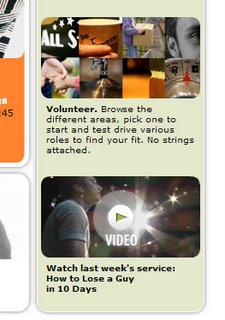 I didn't post earlier due to all the activity surrounding the Innovative Church Conference, but I think it's time to talk about the Nip/Tuck to website (gccwired.com). Of course the cat's already out of the bag (see what Tony and Kem have to say about the updated look).
I didn't post earlier due to all the activity surrounding the Innovative Church Conference, but I think it's time to talk about the Nip/Tuck to website (gccwired.com). Of course the cat's already out of the bag (see what Tony and Kem have to say about the updated look).
Aspire!One comes through again. Last Wednesday evening the new look went live. The image to the left is a small illustration showing the softer/rounded feel. It also shows the main page link to one of our newer features - the message in streaming video (available for one week). This image has a flash overlay with moving objects to catch the eye.
The Media Player has also been completely redesigned with enhanced functionality, a new look to resemble the website and the ability to save playlists and email links to friends (just to mention a few cool upgrades).
Stop by and check things out next time you're in the neighborhood!
24 September 2006
ICC | Web Strategy Breakout
Online Resources
For those of you that attended the Web Strategy Breakout on Thursday, September 22, 2006 - here is the list of resources we talked about (with some extras):
Vendors:
- Aspire!One (our web stategists)
- Fellowship One (web based content management system)
- Christian Video Channel (video streaming)
- Light Cast Media (video streaming)
- NetSuite (top notch e-commerce solution)
Partners:
- Web Empowered Church (WEC) (a community of churches sharing web and internet technologies)
Blogs / RSS Feeds:
- Less Clutter & Noise (web strategy by Kem Meyer Director of Communications at GCC)
- A List Apart (web design)
- Creative Multimedia (all things media)
- Kirupa (web design / tutorials)
- Leave it Behind (Brian Bailey Web Director Fellowship Church)
- Ordered List (Steve Smith Web Developer Notre Dame)
- Web Developer (everything to do with web design)
- 3Cords (a community of Christian bloggers)
Tools:
- Web Design & Development (Macromedia Dreamweaver, Macromedia Contribute, Macromedia Flash all part of Macromedia Studio 8, The Web Developers Handbook, Yahoo Developer Network)
- Imaging / Graphics / Photography (Adobe Illustrator, Adobe Photoshop, Macromedia Fireworks, iStockPhoto, Stock Exchange, Big Shot Media, Veer, Flickr)
- Video (Adobe Premiere Pro, QuickTime Pro, Flash 8 Pro Video Codec, Sorenson Squeeze 4)
- Streaming Video (See Christian Video Channel and Light Cast above for streaming services, See Sorenson Squeeze 4 above for video compression and the ability to convert digital video into QuickTime (.mov), Windows Media (.wmv), Flash Video (.flv) etc. FFMPEG is also a popular compression tool that is open source and highly customizable though typically not for the beginner)
Hope this simple list is helpful. Feel free to add comments regarding the pros/cons of the listed resources and/or list alternatives that have been useful in your experience.
Web 2.N0?
(FoxTrot by Bill Amend)
Thought this was funny - not because I'm anti-Web 2.0, but because I resonate with the concept of moderation (in most things). When I made the switch from volunteer to full time ministry I quickly realized that I had more time to research and incorporate the latest technology into my design work. Web 2.0 concepts, AJAX, increased use of javascript and searching for cool (usable) open source aps rank high on my "2 Do" list but I'm also trying to keep it simple and stick to what works well.
It's a fun ride and I'm looking forward to the wealth of knowledge that is just around the corner.
Open mouth insert fire hose...
22 September 2006
ICC (Day 2)
 Mark Waltz & Butch Whitmire (The GCC Experience: by design)
Mark Waltz & Butch Whitmire (The GCC Experience: by design)
Managing the process of creating ideas and avoiding burnout. Discussed the series planning process (Excel spreadsheet/flowchart) and how GCC works from brainstorm to final series title with specific messages and arts elements. Good discussion on how or if to use the various elements based on the climate or specific orientation of the church.
(Arts elements: (too numerous to post all of them) but here are a few: ViewMaster, Letter From God, The Cleavers, More Than a Number, Everybody's Fool, etc.)
Mark Batterson (We're not alone)
Mark talked about the struggles and successes of his church ministry in Washington D.C. (National Community Church).
One of the sites (multi-site church) is in a coffee house built by the church off the premise that Jesus hung out by wells to talk to people since wells were where people met, drank and shared conversation.
Spoke on the power of technology and its use at NCC.
- Podcasting ("supplement" versus "substitute" to ministry)
- Blogging (getting information out at the speed of the blogosphere)
5 Final Thoughts (based on the NCC journey)
- Enjoy the journey - Don't get lost in expectation, but enjoy the process
- Be yourself - Don't try to be all things to all people or measure up to other peoples expectations
- Stop criticizing - Be known for what you're for rather than what you're against
- Offend pharisees - Choose to offend the "traditional" establishment or religiosity rather than the Holy Spirit
- Make mistakes - They can be learned from and often are the moments you look back on and smile/laugh
Perry Noble (We're not alone)
Perry is the senior pastor at NewSpring Church and presented on the problem with inaction. He encouraged pastors to be proactive and take action so disengaged people will be reached.
4 Strategies (based on the NewSpring Church journey)
- Engage - Church has been boring for far too long - why perpetuate the problem? Church should be the most engaging place on the planet because Christians have the most engaging story there is
- Enlarge - Grow the kingdom and count the numbers! Focus on "felt need" rather than the stuff the "steeple people" demand. If you go after the type of people that nobody else wants - you won't be able to stop the growth that occurs
- Endure - Teach people in the church how to minister to each other and the church won't fall apart when the pastor isn't there
- Enable - See people discover their potential in Christ through the process of volunteer ministry
[time of worship - awesome]
(Other arts elements thrown in: We Are Family, King Without a Crown)
Mark Beeson (Are we up to the challenge?)
Finished up the day discussing the delivery of the arts as a challenge we must accept. But to be sure we understand that the church itself is NOT theatre - where everyone plays along as if the storyline is fake or made up. People matter! Arts are leveraged for the purpose of helping people understand the human condition - not live in denial when it comes to real life problems, hurts and needs.
What GCC learned in the last year:
- We must focus (Focus on 5)
(Arts element: Fix You)
21 September 2006
ICC (Day 1)
 Mark Beeson (Just who do you think you're talking to?)
Mark Beeson (Just who do you think you're talking to?)
Session 1 opened with the Senior Pastor of Granger Community Church discussing the topic of relevance and the population we serve in our immediate communities. Music, drama and media were used to show examples of the modalities used at the church to reach the community with the love of Christ.
(Arts elements: Move Along and iDate)
Tim Stevens (What's buzz? What's worthy? What's buzz-worthy?)
Session 2 included Tim Stevens discussion on buzz and buzz-worthiness. The idea that buzz can be created and yet can also happen at times without determined effort. Buzz takes on a life of its own and can be leveraged in the cause of Christ.
Pop culture said to be the language of our day and if this "filter" is used, our impact on the culture can be more profound than if pop culture is viewed as evil or bad. You can Ignore, separate, Condemn, Embrace or Leverage the culture. It's up to us.
(Arts elements: PureSex ad campaign used to show the life of "buzz." The Date and Dirty Little Secret used from PureSex series)
Rob Wegner (Is anybody listening?)
Rob spoke on the influence of marketing and "noise" on everyone in today's culture. And how you never know the influence you can have on someone - the idea that every time we step up to the plate (do a service) there will be someone in the audience at the end of his or her rope.
Because of this our interactions must be intentional - abstract rather than a linear evolution of steps and preconceived ideas. What if we programmed our services this way?
Communication works best (lives get changed) when the following three elements/stories overlap:
- My Story (use vulnerability and humor)
- Their Story (taper the story to the focus audience and allow your people to tell their stories)
- God's Story (offer the historical dimension and the story dimension but don't end the story - allow the person to finish the story by asking follow up questions)
(Arts elements: Shane & Shane opened with worship. Numerous clips of GCC teaching pastors.)
20 September 2006
IT Round Table
 I was able to pop in on the IT Roundtable (WiredChurches.com Workshop) led by our very own Jason Powell and hear great conversation about a variety of IT issues. The discussions went from the use of volunteers to permissions to streaming and the use of inkjet versus network printers. The topics were often out of my realm of expertise, but interesting nonetheless.
I was able to pop in on the IT Roundtable (WiredChurches.com Workshop) led by our very own Jason Powell and hear great conversation about a variety of IT issues. The discussions went from the use of volunteers to permissions to streaming and the use of inkjet versus network printers. The topics were often out of my realm of expertise, but interesting nonetheless.
It was great to see people from a number of churches working together to define best practices and share information that the typical business would lock down in hopes of securing their share of the market.
Also had some interesting conversations on upcoming technology and software like Windows Vista.
Oh, and there were more laptops in the room than people I think...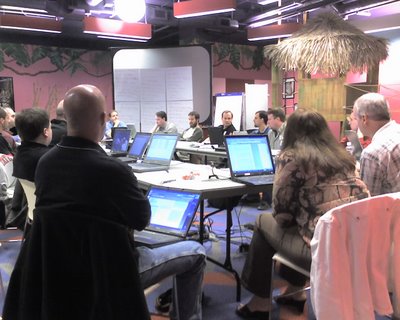
18 September 2006
ICC On the Way
 ICC is coming quickly! This is my first experience with ICC (both attending and presenting.) I have been in a volunteer role at the church for over two years but was never able to join in the fun - until now.
ICC is coming quickly! This is my first experience with ICC (both attending and presenting.) I have been in a volunteer role at the church for over two years but was never able to join in the fun - until now.
The past few weeks have been all about ICC from the promotional side of things, the registration, the materials, the "being ready" for over 600 people and preparing for your little piece of the puzzle.
I get to attend some great sessions over the next few days, including those from Perry Noble and Mark Batterson. I will also be part of the following breakout sessions:
- Web Strategy Breakout with Kem Meyer (Thursday, 9/21/06)
- Blogging Breakout with Tony Morgan, Kem Meyer and Jason Powell (Friday, 9/22/06)
Stay tuned for updates!
13 September 2006
Definitive Definition
 Over the past few weeks I've had opportunity to be in conversation with people on staff and in other organizations who are actively pursuing excellence in media presentation. For the purpose of WDC we'll keep our discussion to best practices in presenting media on the web.
Over the past few weeks I've had opportunity to be in conversation with people on staff and in other organizations who are actively pursuing excellence in media presentation. For the purpose of WDC we'll keep our discussion to best practices in presenting media on the web.
Now I know the term "media" can refer to all sorts of things, but what I'm really talking about is video. With the availability of hi-speed internet connections, we are quickly moving away from simple HTML pages sprinkled with graphics and the occasional audio clip to rich media sites with intense flash interactivity and (up to) High Definition video.
Just look at the Apple website and their use of media (video) for movie trailers. These video clips are offered in a variety of formats so the user can get the best experience based on their connection speed and willingness to wait:
- Small
- Medium
- Large
- HD 480p
- HD 720p
- HD 1080p
When deciding how you want to display media on your website, consider the following things:
Format
There are a variety of formats available for displaying video on the web. The big players have always been Real video, Windows Media and QuickTime formats. But more recently flash jumped into the game by developing the Flash Video format.
The most common aspect ratios for video are 4:3 (standard television) and 16:9 (widescreen). With the push toward High Definition (HD) most televisions are being built with a 16:9 screen and some of the new video cameras are capable of shooting video in the 16:9 aspect ratio.
File Size
When displaying video on the web, you must be aware of the effect it will have on the end user. Keep in mind there are still people using dial-up. But even broadband users can't view video in full HD format yet without a long wait. For example: Trailers for most official movie websites range from 3-5MB for the small clip to 100MB for the HD 1080p format.
Display Format
Another thing that might come up is the way the video is displayed. Here are the most popular ways to present video on the web:
- Embedded in a traditional web page on your site
- Popped up in a new window
- Popped up in the respective player (QuickTime Player, Windows Media Player, Flash Player, etc.)
- Managed through a Media Player designed to organize, display and play video clips as part of a media library
Our Solution
At granger we have chosen to convert all video into flash video (.flv) and present it in a Media Player. Our file sizes vary but are usually 15-25MB for a 3-5 minute clip. We have employed a variable aspect ratio presentation format due to our current video library. The player is in the 4:3 format, but can play the 16:9 clips in the typical letterbox format. Using Sorenson Squeeze we convert large QuickTime files (.mov) into the flash video format (.flv) using the setting for a 768K to 1Mbps stream at 360x270. This provides for excellent quality in this size and decent quality when viewed at 200% of the original. The majority of our clips are still in the 4:3 aspect ratio, but we have determined that all future media will be produced at 16:9 when possible.
As far as HD goes we're getting there. But the cost of cameras, hardware and software can get in the way. Also, it takes an incredible amount of server space to record an entire service in HD.
But! Where there's a will, there's a way.
For now we'll work on getting our video in the 16:9 aspect ratio and who knows - someday we may offer all video in 480p, 720p or 1080p!
08 September 2006
Getting Closer!
 I posted about the launch of IE 7 Beta 2 a while ago, but never offered a follow up post on some of the issues I began to have. The main one was a glitch (or at least I think it was a glitch) where I would lose all my ftp connection settings in Dreamweaver when I closed the program. Each time I opened Dreamweaver it would say "Not able to connect to remote host" and when I would get into the site properties there would be no user/password info there. It started the minute I began using the beta version of IE7 and ended the minute I uninstalled it. My wife also noticed some issues on her Dell Inspiron E1505 that went away when IE7 was uninstalled.
I posted about the launch of IE 7 Beta 2 a while ago, but never offered a follow up post on some of the issues I began to have. The main one was a glitch (or at least I think it was a glitch) where I would lose all my ftp connection settings in Dreamweaver when I closed the program. Each time I opened Dreamweaver it would say "Not able to connect to remote host" and when I would get into the site properties there would be no user/password info there. It started the minute I began using the beta version of IE7 and ended the minute I uninstalled it. My wife also noticed some issues on her Dell Inspiron E1505 that went away when IE7 was uninstalled.
So I just resigned myself to the fact that I'd have to wait until the official release in order to use IE7. But this week I checked out the site again and saw that they are in the final stages and are offering the IE7 RC1 (Release Candidate 1). I jumped back in and I'm glad to say I have not had the same Dreamweaver glitch with this release.
I'm not saying I won't experience some problems in the future, but right now I'm really loving the new look and the tabbed browsing. RSS feature is cool, but it's hard to compete with something as functional as Bloglines.
From a development standpoint, I'm also looking forward to the day when all browsers play nice and agree on the same web standards (mainly where css properties are concerned) - hopefully this is a step in the right direction...
The First 10 Days
 Call it what you will, but it's my little slice of heaven. I am currently sitting in a cubicle next to the other brilliant people in the communications department (aka: "the fun hallway") and its already beginning to feel like home. Soon I'll have a docking station with peripherals that can be left plugged in - making for quick in/out trips with the notebook.
Call it what you will, but it's my little slice of heaven. I am currently sitting in a cubicle next to the other brilliant people in the communications department (aka: "the fun hallway") and its already beginning to feel like home. Soon I'll have a docking station with peripherals that can be left plugged in - making for quick in/out trips with the notebook.
Speaking of notebook - I've spent the past week putting it back together (thanks JP!). Our IT Guru did his job in getting me hooked up to the network with synchronized folders and all, but it created a new profile which has made things interesting. Complete overhaul on the file structure (moving and categorizing files/folders), re-customizing the look/feel of the desktop and applied aps and finally, going through the startup process with each application as if it were the first time I'd ever used it!
This process took some time, but like spring cleaning I was able to get rid of some cobwebs and reach a new level of organization that should keep me going for a while...
As for the job description, its a lot of the same stuff I've been doing as a volunteer with a few new projects thrown in. Some cross-training on backend/interface solutions and jumping into a few big projects that should hit the public between the end of this month and early next year (no details available...)
I'm loving every minute of it!
23 August 2006
It's Official | New Look
 I have been doing volunteer ministry in the communications department at Granger for over two years now. It began with basic web maintenance and some simple graphic design work and has blossomed into two full-blown websites complete with dynamic back-end administration panels, integration with the current CMS used by the church, flash navigation, flash feature sections on main and series pages, and media features that are taking us to entirely new heights.
I have been doing volunteer ministry in the communications department at Granger for over two years now. It began with basic web maintenance and some simple graphic design work and has blossomed into two full-blown websites complete with dynamic back-end administration panels, integration with the current CMS used by the church, flash navigation, flash feature sections on main and series pages, and media features that are taking us to entirely new heights.
It has been awesome to work with the team on these projects and peer into the future together. But from now on it will be from a slightly different perspective.
I recently began talks with the Administrative Pastor (Tony Morgan) about what it would look like to actually move into full time ministry at the church. This would mean leaving a career in the mental health field to do something totally different.
After much prayer, personal reflection (and of course conversations with my wife) I (we) accepted the position as Web Director at the church.
My first day at the church will be September 5th.
On one hand this is just a continuation of my two years of ministry. But on the other hand it is a brand new adventure - an incredible opportunity that I believe God was preparing me for with years of leading, teaching and testing.
I'm looking forward to this next leg of the journey!
New Look
You might be asking yourself why the site looks so different. Well, lets just say I thought a small face lift was in order to celebrate the transition. Hope you like it!
03 August 2006
The Broadband Church
 I was reviewing local and regional stats on the use of dial-up versus broadband recently and was surprised to see that the percentage of broadband users was less than 30%!
I was reviewing local and regional stats on the use of dial-up versus broadband recently and was surprised to see that the percentage of broadband users was less than 30%!
My mind started racing with questions about our site, the target audience, the pageloads, our optimization practices with both images and flash elements, etc. I emailed a few people on the team and ran some questions by them. And when it was all said and done, we'd dotted all the "i's" and crossed all the "t's."
You see as it turns out, our site (gccwired.com) is still accessible to dial-up users (though I wouldn't spend a lot of time trying to view video clips in the media player) so no one is being excluded.
Also, our target audience is much more likely to use broadband that dial-up regardless what the regional stats are showing.
Because of this, we have chosen to design the site with the broadband user in mind. This allows greater flexibility in the technologies used and allows us to keep our sites fixed on cutting edge technology as we strive for excellence in web communications.
With HD on the horizon and other more interactive web applications popping up every day, the future is looking bright. Better get my shades...
Tony Morgan, Administrative Pastor at Granger Community Church and one of the Simply Strategic Guys, put it this way:
20 June 2006
GCC Mailbag
I've recently responded to a number of inquiries about the Media Player and Evite components on gccwired.com. Most are questioning who designed them and if they are third part plugins that can be purchased for use on their websites.
Unfortunately I must answer "No" to these inquiries. Both the Media Player and Evite components were designed and coded by our designers at Aspire!One.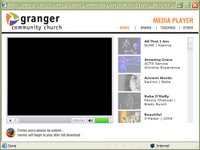 The Media Player is a flash interface that has an XML driven playlist. We create the thumbnail images and convert our media into flash video (.flv files). All parts are uploaded to the server and the player dynamically pulls the thumbnails to populate the playlist and creates the link to play the flash video clip in the window on the left.
The Media Player is a flash interface that has an XML driven playlist. We create the thumbnail images and convert our media into flash video (.flv files). All parts are uploaded to the server and the player dynamically pulls the thumbnails to populate the playlist and creates the link to play the flash video clip in the window on the left.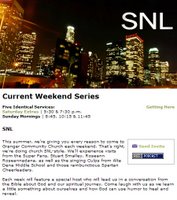 Similarly the Evite component was coded and integrated into the administration panel used to maintain the site. We have the option to add the Evite component to any new page we create. There is an Evite text entry box in the admin panel that allows you to add copy and html as needed when creating a "story" for publication on the site. When the "story" runs on a page, the evite link is visible and pops up a window with the appropriate copy/images for that "story" (usually an event or service).
Similarly the Evite component was coded and integrated into the administration panel used to maintain the site. We have the option to add the Evite component to any new page we create. There is an Evite text entry box in the admin panel that allows you to add copy and html as needed when creating a "story" for publication on the site. When the "story" runs on a page, the evite link is visible and pops up a window with the appropriate copy/images for that "story" (usually an event or service).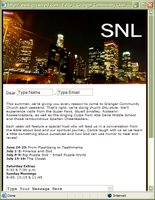
Thanks for your inquiries and keep them coming!
08 May 2006
What Does the Future Hold?
 Recently I have been peering into the future - attempting to figure out what the Internet might look like 10 years from now, 5 years from now or even 1 year from now for that matter.
Recently I have been peering into the future - attempting to figure out what the Internet might look like 10 years from now, 5 years from now or even 1 year from now for that matter.
Audio is quickly becoming exclusive to the "podcast" while video is quickly becoming the media standard on the web. And one could assume that audio-only information may one day be completely done away with if a video version is always an option.
With the increasing availability of DSL and broadband connections, the development of streaming servers and the use of streaming video (often in flash video (.fla) format), the possibilities appear to be endless.
But in my humble opinion, it seems like all this advancement could meet a dead end someday. And here is why I say that:
Doesn't it make sense that technology (not all technology, but the technology that drives media via the Internet) only needs to develop to a certain point. In other words, won't this technology someday reach it's full potential? Won't it get to the point where any further advancement would be undetectable to the human given our earthly limitations?
Allow me to get more specific:
- At some point the quality of audio ceases to be important because the ear cannot tell the difference beyond that
- At some point the quality of video will cease to be important because our eyes will not be able to tell the difference beyond that
- When your broadband connection is capable of streaming this level of audio and video to the device of your choice, any speed above and beyond that may cease to be important (unless it's to download gargantuan files that require greater bandwidth)
- When you are able to get anything, from anywhere, at any given time, in any format, on whatever device you desire - isn't that good enough?
This is what I'm talking about. This is what I'm trying to figure out. This is the underlying hypothesis that drives my questions about the Internet and how we will be using it in the next few years.
All you have to do is look at the iPod revolution which allows you to carry video in your pocket. And some of the new features on the web like the way ABC now offers streaming video of some of their popular shows each week.
The Church must harness the power of this technology if it is to be relevant in the upcoming years. I love being a part of it and can't wait to see what's next.
11 April 2006
Include Me Please
I'm not a huge programmer, but I love to learn small tricks that make my workflow easier. One such trick is the Server Side Include (SSI) or PHP Include. These awesome little workhorses make designing a dynamic website a bit more time intensive on the front end, but much easier in the long run.
(Very) Simple Explanation
An "include" is a short function that you place in your HTML/XHTML page. It is just one line that says something like "include "your_document.html" or something like that.
Go here for full explanations: Server Side Includes / PHP includes
When the browser gets to this function it goes looking for the "your_document" file and "includes" it in the page. If "your_document" is a text file that says, "Hi - I'm an include" then "Hi - I'm an include" will show up on your page.
The cool thing is that you can now duplicate this HTML/XHTML page as many times as you want and each page will still pull "your_document" into that page. This allows you to make global changes in a websites look and feel by simply changing the "your_document" file.
In the past I used includes for navigation only. I would create an HTML page called "nav.html" and it would just be a list of links. Each page called this file to populate the navigation panel on that page. If I wanted to add a link to the site, I simply updated the "nav.html" page and every page on the site had the new link!
However recently I have experimented with includes for headers, navigation, footers, and even simple form elements.
Coupling includes with the power of Cascading Style Sheets (CSS) makes website maintenance a breeze and makes routine site enhancements much more doable.
25 March 2006
I'm a Sucker for the New Stuff
 I love a new idea, product or version of a product that makes life easier for everyone. So it is no wonder I am constantly on the lookout for the latest and greatest in browser technology.
I love a new idea, product or version of a product that makes life easier for everyone. So it is no wonder I am constantly on the lookout for the latest and greatest in browser technology.
I am staying away from Netscape for now, but use IE6 and Firefox interchangeably. IE is the standby that never fails, while Firefox offers the cool features and has awesome extensions to personalize and maximize the performance.
But the other day (3/20/06) IE7 Beta 2 was made available and I have been trying it out to see what I think. So far I love it! Reminds me a lot of Firefox with integrated RSS feed management and tabbed browsing. I like the new minimalist approach to the toolbars and the floating favorites menu that can either fly out or be pinned to the sidebar. Also, check out the zoom feature to see the small stuff!
Of course there are drawbacks to any Beta version (I purposefully did NOT try Beta 1 to avoid the initial bugs). Already I see some issues with flash objects (requires you to click on them initially to make them active) but I haven't had it long enough to give a full list of my likes/dislikes. The thing I'm really looking forward to is whether or not microsoft is going to play nice and work toward standardization for cascading style sheet (css) support...
Hopefully after a bit more work, they will release IE7 and the world will be a better place for all of us!
11 March 2006
Blog Software Rocks
 I've been using Blogger for quite a while now with no problems and excellent flexibility. Sure there are more robust applications out there (TypePad, WordPress, etc.) but for now I'm happy with the simplicity of Blogger for personal blogging and even for some side projects I have been working on.
I've been using Blogger for quite a while now with no problems and excellent flexibility. Sure there are more robust applications out there (TypePad, WordPress, etc.) but for now I'm happy with the simplicity of Blogger for personal blogging and even for some side projects I have been working on.
For example, I am currently doing a website that will have four sections completely driven by Blogger. The Blogger Admin Panel serves as the Content Management System (CMS) for the pages which allows "less techie" people control over the site in a more dynamic way. The awesome thing is this: the people who will be updating these pages are already bloggers! So there is NO learning curve (how cool is that?)
All the work is in the front end - incorporating the Blogger specific tags into your existing page (similar to html tags but are dynamic to call data from the appropriate places after a post has been published). After that it's a detailed incorporation of your sites stylesheet.css and the styles from the blog template (if you're stripping down an existing one) and that's a wrap.
Blogger allows two publishing formats. The first (and easiest) is to publish all posts/images to the Blogger servers (called "blogspot"). But the second option is the one that rocks! Blogger will publish posts/images directly to your website via ftp or sftp. Simply enter the correct path(s) to the correct directory(ies) and Blogger does the rest...
What was designed for blogging can just as easily be used as a CMS!
Thanks for everything Google!
04 March 2006
Culture of Excellence
 One of the best things about doing ministry with the technology and communications team at Granger Community Church is being able to work with top notch professionals. Not just because they are good at what they do, but because they go the extra mile to ensure what they are doing meets a "higher" standard of quality.
One of the best things about doing ministry with the technology and communications team at Granger Community Church is being able to work with top notch professionals. Not just because they are good at what they do, but because they go the extra mile to ensure what they are doing meets a "higher" standard of quality.
I guess you could call it a "culture of excellence." It's an understanding that something should only be done if it's going to be done well. And I've seen it over and over again. We will come up with an idea, develop it, possibly even test it out a bit but then trash it if quality isn't there or if there isn't a support team in place to back it up and ensure longevity.
For years I have worked in the field of mental health and unfortunately strategic planning is often the last thing tried. In fact, what usually happens is the old "knee-jerk" reaction where you experience a problem and quickly slap a bandaid on it. However, this bandaid quickly falls off and the problem is still there. "Plans" are often initiated just to show that something was done to address the problem - regardless if it is a good solution or not.
But with this team, it seems like everything is well thought out. You weigh the pros and cons long before making something policy.
A good example of this is our web strategy which consists of the following:
- Overall site design (what we call "heavy lifting") will be outsourced. Aspire!One designed our websites, the content management systems behind the scenes and will complete any full-scale site improvements or large upgrade projects.
- Staff at GCC keep the site running smoothly by adding and removing content on a regular basis.
- Volunteers add value to the team by helping out with maintenance, developing graphics, adding flash content, doing simple layout/scripting projects, etc.
It's an awesome strategy that has worked well since I've been involved at the church.
I can't wait to see what the next 5 years brings!
26 February 2006
May I Help You?
One of the cool things I get to do once and a while is answer web-related questions that come in via phone or email. The way I look at it - I ought to give back since there have been numerous others that have patiently answered my questions and taught me little tricks to make my life easier.
So I thought I'd give you a sample request and what I sent in response:
Bob wrote:Here is my response:
I am looking around for web site companies to use for our church and I was wondering how well Aspire!One has worked for you. Do they provide great tools? How much of your site do you do in house? Do they have a great feature that just makes them stand out?
Bob,
Sorry I didn't get back to you right away. I've been doing MACH 10 for the past week or two but have some time this weekend to respond.
Prior to Aspire!One we were using a small wed development company that posed numerous problems to our site, our ability to maintain the site and our ability to expand our site and integrate with our backend database.
We began talks with Aspire and things went very well from day one. They had meetings with us to hear our vision and to see what our needs were. They did phone conferences and were available every time we reached a milestone in the preliminary design phase and development process.
Our site is dynamic in that it is based on a number of templates (some pre-designed by Aspire but others we have modified as needs change). Each template is populated with content or data entered through a central Admin Panel [see screen grab below]." Data are entered as stories that can be used in their totality (as a full HTML page) or in smaller chunks on other pages (in a sidebar or on the main index page for example). When a page is scheduled to be in a sidebar of an existing page, the only information sent is the thumbnail graphic and the title or subtitle. This then links back to the full story.
This concept may be difficult to understand without seeing it in action. But this is the basis for the entire site. We have some flexibility within the admin panel to edit the html and we can use Dreamweaver to develop more robust pages or templates if we need to.
The cool thing about this Admin Panel is that it allows varying "permission" levels, so someone can enter the panel and only see/edit certain things. I could go in later and schedule story that person wrote. This is huge in helping maintain consistency and standardization requirements necessary to keep the site looking professional.
Another awesome feature is the ability to schedule stories to appear on a certain date, and then leave on a certain date. This proactive approach to web maintenance is not only helpful to our team, but will probably be the standard in the near future.
Aspire has been very approachable and helpful in customizing the website and Admin Panel to our specific needs. They are great to work with and I look forward to a long relationship with them for both minor adjustments and major site overhauls in the future.
Hope this helped. Let me know if you have more questions about Aspire!One or gccwired.com.
Taking the Message to the world via the web...
Daryl

19 February 2006
50 Feet of Pure Media Bliss
 I know - I'm way behind the times. We have some prolific bloggers at the church - some manage to post on stuff that hasn't even happened yet (you know who you are). But I thought I'd post about the new screen since I probably look at it in a slightly different way than the average person.
I know - I'm way behind the times. We have some prolific bloggers at the church - some manage to post on stuff that hasn't even happened yet (you know who you are). But I thought I'd post about the new screen since I probably look at it in a slightly different way than the average person.
You see, when I look at the screen, I see pixels and resolution. I asked myself how graphics would need to be designed in order to fill the entire screen and what resolution would be required, etc. Then I thought about future flash movies and how the initial design would influence their appearance on the big screen.
Oh yeah - and it also looks awesome during a service...
See Jason's post for the installation and technical specs on the new screen and the system that runs it.
16 February 2006
Can You Hear the Buzz?
 I was approached a while ago about helping the church create buzz about their upcoming sex series. It would be a 5 week series held on the weekend, and would be promoted just a bit differently that other series we have had.
I was approached a while ago about helping the church create buzz about their upcoming sex series. It would be a 5 week series held on the weekend, and would be promoted just a bit differently that other series we have had.
This was the brainstorm:
- Rent a few billboards around town.
- Throw up a picture that has nothing to do with the church (and everything to do with sex).
- Acquire a domain name just for this series (mylamesexlife.com).
- Develop a Flash Movie to walk people through a few introspective questions about their views and emotional responses to sex.
- Have the Flash movie redirect at the end to another page (on gccwired.com).
- This page (with series details) would introduce people to the fact that it IS safe to talk about sex in church!
I jumped at the opportunity because I love Macromedia Flash and it was something that would test my abilities. The cool thing was the fact that there were a team of others behind me the whole way. Pictures were expertly chosen and sent my way, the copy was well written and emailed to me, the audio was custom fitted by an audio guru at the church and others edited and commented along the way to make sure we had the best possible product (thanks all!).
The project had been done for a few days, and I allowed myself to sit back and relax - only to be shocked back into reality when the billboards went live and the hits began to roll in on the site. Local news picked it up and a radio station dedicated an entire morning to the billboards by starting a discussion and allowing listeners to weigh in.
I'll admit I was a little overwhelmed - but then again, God has been doing things on a grand scale ever since He created this little planet and He wants to do even bigger things through those willing to tag along...
I can hear the buzz - can you?
See what others are saying: Becky, Corey, Jason, Kem, Tony, and More Tony
09 February 2006
Should I Be Worried? Or Just Angry?
 I have always remained faithful to Macromedia products for a number of reasons. First, they were what I started using when I began my journey. Second, they have done everything I've ever asked them to do. And third, the competition really turned me off (Microsoft and Adobe products mainly). So you can imagine my shock and fear when they announced the merger between Macromedia and Adobe.
I have always remained faithful to Macromedia products for a number of reasons. First, they were what I started using when I began my journey. Second, they have done everything I've ever asked them to do. And third, the competition really turned me off (Microsoft and Adobe products mainly). So you can imagine my shock and fear when they announced the merger between Macromedia and Adobe.
How can they do this? I asked myself. You can see from the graphic above, times are changing! They are already bundling Macromedia Studio 8 with Adobe CS2. But I can see at some point being able to purchase one combined "web developer" product - possibly the following:
- Dreamweaver (better not mess with that...)
- Flash (better not mess with that...)
- Photoshop
- Premiere (possibly for working with video?)
- Illustrator
- Acrobat
I envision Fireworks and Freehand going away for good. Very sad, but with the power of Photoshop, it just makes good business sense.
So we'll have to see how it all works out. But my question still begs to be answered, "Should I be worried? Or just angry?"
07 February 2006
It's Not About Me
Actually, it is. This post I mean. But only so I can give you a snapshot of my life story. And once you see that I think you'll agree that it's NOT about me - it's all about Him.
I currently work as the Program Manager of a psychiatric inpatient unit in Plymouth, Indiana. I am a therapist by trade (licensed clinical social worker) and did that for a few years before making the transition into management. Definitely a far cry from the world of the web (in fact it was like pulling teeth just to get computers in the facility).
But somewhere in my not so distant past I began getting into computers, web design and the like. Not the traditional way (taking classes toward a degree) but by simply diving in, buying the software and teaching myself the ropes. Books, the help of friends and online tutorials have been more beneficial to me than any class I could have paid an arm and a leg for...
Back in the day I put all my energy into learning new ideas. I practiced on my own website and would redesign it every few months just to try my hand at the new things I had learned. At one point I purchased Macromedia Flash 5 and redesigned the entire site as a flash movie (not such a cool thing now...)
Then the day arrived when a friend of mine said, "I think there is someone you should meet."
So I did. After one meeting with the Communications Director at the church I was attending, I began to volunteer my time doing web design, web maintenance and anything else that came up. After a few months I was hooked. Something changed inside me and there was no turning back.
My hobby suddenly took on new meaning and relevance. I now had a purpose behind my interest which opened a new realm of possibilities. I have learned more than I thought possible and have been able to add value in a variety of ways.
So that's why it's NOT about me. I'm NOT a web designer by trade. For all intents and purposes I shouldn't even be able to do this stuff! But He had a plan. He put the thought in my head and He gave me the abilities I have. Without Him guiding me I might still be coming home every night and just plopping down in front of the TV (oh wait - I still do that a lot...)
I stand in amazement at what God can do with a life. We just have to be willing.
05 February 2006
Welcome to WebDrivenChurch.com
I worked for years in the mental health field as a licensed clinical social worker (LCSW). Then, in 2004 I was asked to volunteer in the Communications Department at Granger Community Church. For two years I helped keep the websites running as the church readied itself to launch completely redesigned versions of their two websites.
Then in 2006 I was asked to join the team on a more permanent basis.
I currently serve in full time ministry as the Web Director at Granger Community Church. I get to work with an incredible team of dedicated professionals. We cast vision for, maintain and oversee all aspects of both gccwired.com and wiredchurches.com.
WebDrivenChurch.com is not only one of my creative outlets, it's also where I get to process day to day goings on and advances in technology that impact progressive churches. If you have any questions about this site or the information presented here feel free to contact me (use contact button in the header menu).
I hope that this will be a safe place to discuss the following:
- Web design/layout
- Web technology
- CSS
- Programming languages (php/xml/javascript/etc.)
- Software/hardware/plug-ins/etc.
- Flash
- Online audio/video
- Podcasting/vodcasting
- Streaming video
- eCommerce
- etc.
Once again, thanks for joining me on this journey.


